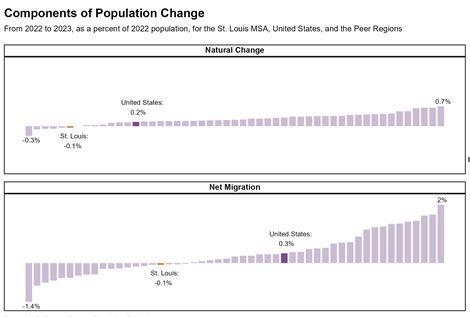Last week’s release of new population data by the U. S. Census Bureau sparked more concern over the general health of the St. Louis region when figures revealed St. Louis had dropped by two in the annual ranking of population growth among 50 peer metropolitan statistical areas (MSA).
St. Louis is now the 23rd most populous region in the country, dropping from 21st in 2022. This is discouraging news, but here are four points about the data from our Research Department that might lessen the sting.
- St. Louis it is not alone in the loss of population. Other large metropolitan U.S. regions, some that are often considered successful, also lost population and experienced net out-migration.
- The St. Louis region’s decline was not as substantial as in recent years.
- The decline in population from 21st to 23rd is more linked to growth in other metro areas as it is to the change in population for St. Louis.
- St. Louis’ net migration loss last year was a fraction of what it was in the two previous years.
Here is an overview of the situation.
From 2022 to 2023, the St. Louis Metropolitan Statistical Area (MSA) ranked 40th for population change with a small decrease of 0.1%. St. Louis was one of 12 peer regions that decreased in population. Among these regions, St. Louis, Cleveland, and Detroit saw the smallest percentage decreases. New Orleans, Los Angeles, New York, and San Francisco were among the regions with greater percentage declines than St. Louis.
Eight additional peer regions experienced growth, but at a rate of 0.1% or less. The United States as a whole saw an increase in population of 0.5%. More than a quarter of the 50 most populous regions in the country grew by less than one-tenth of 1 percent from 2022 to 2023.

From 2022 to 2023, St. Louis experienced a net loss of 5,603 people due to migration within the United States. Partially offsetting this outflow, the region had a net gain of 3,856 in international migration. The total net decrease in population due to migrations was 1,747. St. Louis ranked 34th on net migration with 16 peer regions experiencing a larger net out-migration in percentage terms. In total, 30 of the 50 most populous regions saw less growth than the United States as a whole (0.3 percent) due to migration. Among the regions that experienced larger percentage decreases in net migration than St. Louis were Portland, Chicago, San Jose, and New York. Orlando and Charlotte, the two regions that passed up St. Louis in total population, were among the four peer regions with the largest growth due to migration, 1.7 and 1.5 percent, respectively.
In the last year, net migration loss for the St. Louis MSA was a fraction of what it was in the previous two years. From 2022 to 2023, 1,750 more people moved out of the region than into the region. In the two years previous, it was 8,400 people and 4,300 people.
In the last year, the decrease in population due to natural change for the St. Louis MSA was half of what it was in each of the two previous years. Most of the peer regions did not see much, if any, growth from natural change. From 2022 to 2023, there were 1,500 more deaths than births in the St. Louis MSA. In each of the previous two years, the number of deaths exceeded the number of births by more than 3,000. The United States experienced a 0.2 percent increase in population due to natural change from 2022 to 2023. Only six of the peer regions experienced natural change at a rate of 0.5 percent or more.
Note: The 50 most populous MSAs are based on the 2020 decennial census. According to the 2023 population estimates, the 50 most populous regions now include Fresno, California and Grand Rapids, Michigan and do not include Hartford, Connecticut and New Orleans, Louisiana.

